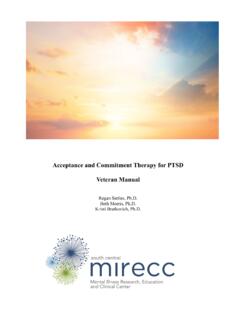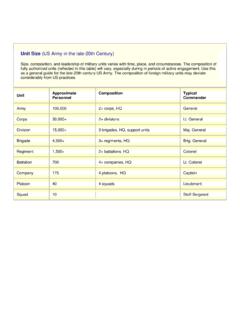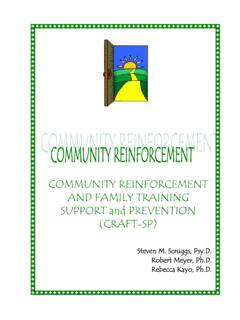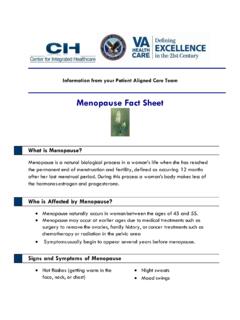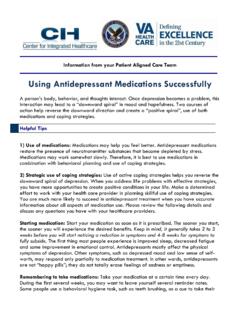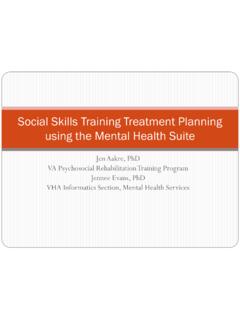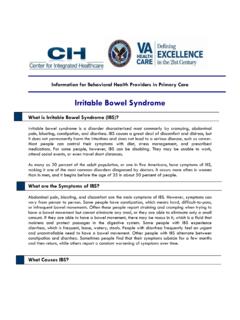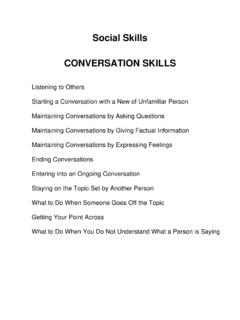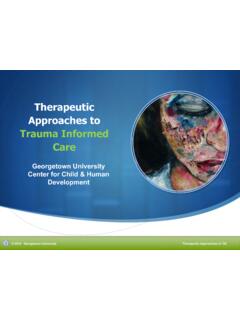Transcription of Stress Less: Relaxation Enhancement Group Therapist …
1 1 Stress less : Relaxation Enhancement Group Therapist Franklin, Corrigan, Chambliss, Repasky,M. Uddo, Walton, & ThompsonVA Medical Center, New Orleans 2nd Edition | 20192 ACKNOWLEDGMENTSThis manual was supported by a clinical educator grant from the VA South Central Mental Illness Research, Education and Clinical Center (MIRECC).The contents of this manual do not represent the views of the Department of Veterans Affairs (VA) or the AND DEVELOPMENT OF THE Relaxation Enhancement (RE) MANUAL Research demonstrates that Relaxation techniques are efficacious for short-term reduction of anxiety and fear in people with anxiety disorders and trauma- and stressor-related These techniques are often included in treatment protocols for posttraumatic Stress disorder (PTSD) and used as coping skills to temporarily address trauma-related anxiety and ,3 To date, little research has been conducted on the effectiveness of Relaxation techniques beyond the therapeutic variables that may explain why Veterans may not practice Relaxation strategies once they leave the Group session include 1) limited understanding of the role Relaxation techniques play in helping them achieve treatment goals, 2)
2 Unavailability of equipment to practice Relaxation outside the Group session, 3) lack of a specific plan regarding how and when to apply these strategies, 4) lack of positive feedback when strategies are appropriately applied and little opportunity to problem solve when difficulties arise, and 5) lack of motivation. To target these potential treatment barriers, we developed and implemented a comprehensive Relaxation Enhancement (RE) protocol. Our goal is to improve Veteran adherence to the practice of Relaxation to reduce short-term anxiety and Stress . The RE protocol includes: 1) a standard rationale for using Relaxation techniques that is discussed in Group , with a copy provided to Veterans for reference, based on various writings of experts in the field of anxiety and PTSD2,3,4,5; 2) Relaxation practices2,5,6 taught in session and conducted by the Group leader to increase Veteran buy-in; 3) a list of resources that include audio downloads of these practices provided to Veterans for use outside of the sessions; 4) strategies for using the resources outlined with each Veteran, including time of day, number of practices per week, and potential barriers to practicing the techniques outside of Group treatment; 5) in- Group discussion of barriers encountered by Veterans; and 6) a Relaxation Log (RL)/wallet card to reinforce improvement in anxiety by the Veteran and to track use of strategies for the Group leader.
3 Please note that this is a brief intervention, meant to provide short-term symptom relief for anxiety and Stress . We recommend that the RE protocol be used as an adjunct to established first-line treatment 4 REFERENCES: 1. Marks IM, Lovell K, Noshirvan H, Livanou M, Thrasher S. Treatment of posttraumatic Stress disorder by exposure and/or cognitive restructuring. Arch Gen Psychiatry. 1998; 55 Foa EB, Rothbaum BO. Treating the Trauma of Rape: Cognitive- behavioral Therapy for PTSD. Guilford Press: New York; Barlow, DH. Anxiety and Its Disorders: The Nature and Treatment of Anxiety and Panic. 2nd ed. Guilford Press: New York; Taylor S, Thordarson DS, Maxfield L, Fedoroff IC, Lovell K, Ogrodniczuk J. Comparative efficacy, speed, and adverse effects of three PTSD treatments: Exposure therapy, EMDR, and Relaxation training. J Consult Clin Psychol. 2003; 71:330-338. 5. Davis MD, Eschleman ER, McKay M.
4 The Relaxation and Stress Reduction Workbook. 7th ed. New Harbinger Publications, Inc.; Oakland, CA; 2019. 6. Najavits LM. Seeking Safety: A Treatment Manual for PTSD and Substance Use. Guilford Press: New York; 2002. 7. Strauss JL, Coeytau R, McDuffie J, Nagi A, Williams J. Efficacy of Complementary and Alternative Medicine Therapies for Posttraumatic Stress Disorder. Washington, DC: Department of Veterans Affairs; Niles BL, Mori DL, Polizzi C, Pless Kaiser A, Weinstein ES, Gershkovich M, et al. A systematic review of randomized trials of mind-body interventions for PTSD. J Clin Psychol. 2018; 74(9) Polusny MA, Erbes CR, Thuras P, et al. Mindfulness-based Stress reduction for posttraumatic Stress disorder among veterans: a randomized clinical trial. JAMA. 2015; 314(5) Jacobson E. Progressive Relaxation . Chicago, IL: Univ. of Chicago Press; 1938. 5 Group STRUCTURE AND CONTENT The RE Group consists of four weekly, 50-minute sessions.
5 The first 25 minutes of each session are psychoeducational. This format allows you to enhance salience and motivation. Group content is based on a compilation of techniques, drawn from the writings of experts working in the Sections of the Stress less Veteran Manual are purposely left blank. Encourage the Veterans to use this space to take notes on the didactic information being presented. The second portion of the RE Group is devoted to learning and practicing Relaxation techniques, each proven efficacious in the short-term reduction of anxiety and management of other PTSD-related symptoms. Inclusion of 4 different techniques maximizes exposure to a variety of Relaxation methods. These techniques include: calm breathing2 (session 1); progressive muscle relaxation10 (PMR; session 2); guided imagery5 (session 3); and grounding (session 4). Assignment of the RL is an important component of the RE protocol.
6 The rationale and importance of the RL are explained during the first session and reinforced during each remaining session. Inform Veterans that the Group will discuss log entries during each remaining Group session. We used a wallet-sized RL to increase the likelihood that Veterans will use the logs and bring them to Group each week. The content and format of the card are below. In session, Veterans should mark the Relaxation technique practiced in a session with an X. The Therapist then instructs the Veteransto mark the additional Relaxation technique(s) practiced outside of the Group session with an X to track their adherence to the LOGMTWThFSSuDeep BreathPMRSelf-HypnosisMental Pictures6 BEFORE BEGINNING The purpose of the RE Group is to help reduce anxiety in the short term. The strategies taught during the sessions will teach Veterans coping skills; however, these skills have not been developed to treat theconditions.
7 Evidence-based psychotherapies (EBPs) for PTSD and other anxiety disorders, if appropriate, should be recommended for the treatment of the underlying illness(es). EBPs for PTSD required to be offered by VA:Cognitive Processing Therapy Gold-Standard TreatmentProlonged Exposure Therapy Gold-Standard TreatmentOther EBPs (as per VA and APA, Division 12)PTSD Eye Movement Desensitization and Reprocessing; Cognitive behavioral Treatment (CBT)GAD CBT; Exposure Therapy; Mindfulness-Based Cognitive Therapy (MBCT); Dialectical Behavior Therapy Panic Disorder CBT; MBCTOCD Exposure and Response Prevention; CBTS ocial Phobia Exposure Therapies; Exposure-Based CBTS pecific Phobia Exposure Therapies, Exposure-Based CBTM easurement-based care is an important tool to understand Veterans anxiety and track improvement.
8 The following list of measures are free to the public to use to assess Veterans: PTSD Life Events Checklist for DSM-5; The PTSD Checklist for the DSM-5 GAD Generalized Anxiety Disorder Scale; Hamilton Anxiety Rating Scale; Severity Measure for Generalized Anxiety DisorderPanic Disorder Panic and Agoraphobia Scale; Severity Measure for Panic DisorderOCD Obsessive Compulsive Inventory Revised; Repetitive Thoughts and Behaviors; Florida Obsessive Compulsive InventorySocial Phobia Severity Measure for Social Anxiety Disorder; Social Phobia Inventory Specific Phobia Severity Measure for Specific PhobiaOther measures will soon be available on the APA, Division 12 s website: 7 SESSION 1: yourself and members of the Group , and review the Group rules and the definition of how managing Stress is especially important for Veterans who are diagnosed with anxiety- ortrauma-related disorders ( , PTSD).
9 The role of Stress (P T Stress D). the analogy of the body as an short- and long-term consequences of unchecked an overview of how this Group will address managing the Subjective Units of Distress Scale (SUDS) to increase Relaxation the format of the Group , including the importance of between-session practices. The RL is usedto record these practices. The RL is not included in the Veteran PRACTICAL Veterans share a SUDS level calm breathing; have Veterans choose a soothing word and write it in their Veteran Veterans complete an RL by putting a mark in the calm breathing box for that #1 calm the RL for this a SUDS for this 1 Group Purpose Increase Veteran understanding of anxiety, and introduce anxiety reduction through lecture and practice application of Relaxation techniques. Group Rules1. Agree to respect the confidentiality of the Group . What happens in Group stays in Group .
10 This will help you feel safe to discuss personal issues if you desire to do Be respectful of one another. You must feel physically and emotionally safe in Group if progress is to be made. You are expected to behave in ways that will not be threatening, intimidating or provoking to others in Group . Please consider giving others the benefit of the doubt. 3. Stay on topic, and refrain from discussing military trauma or compensation issues, as this will take the focus away from the major reason you came to To maximize what you get out of the Group , attend all sessions. Call in advance if for any reason you cannot Silence your cell phones before each Group session. Defining stressStress = tension, hassle, worry, strain, nervousness, ANXIETY Anxiety affects 3 areas: I. Physiological heart palpitations, rapid breathing, muscle tension, sweating, trembling II. Psychological apprehension or uneasiness III.
